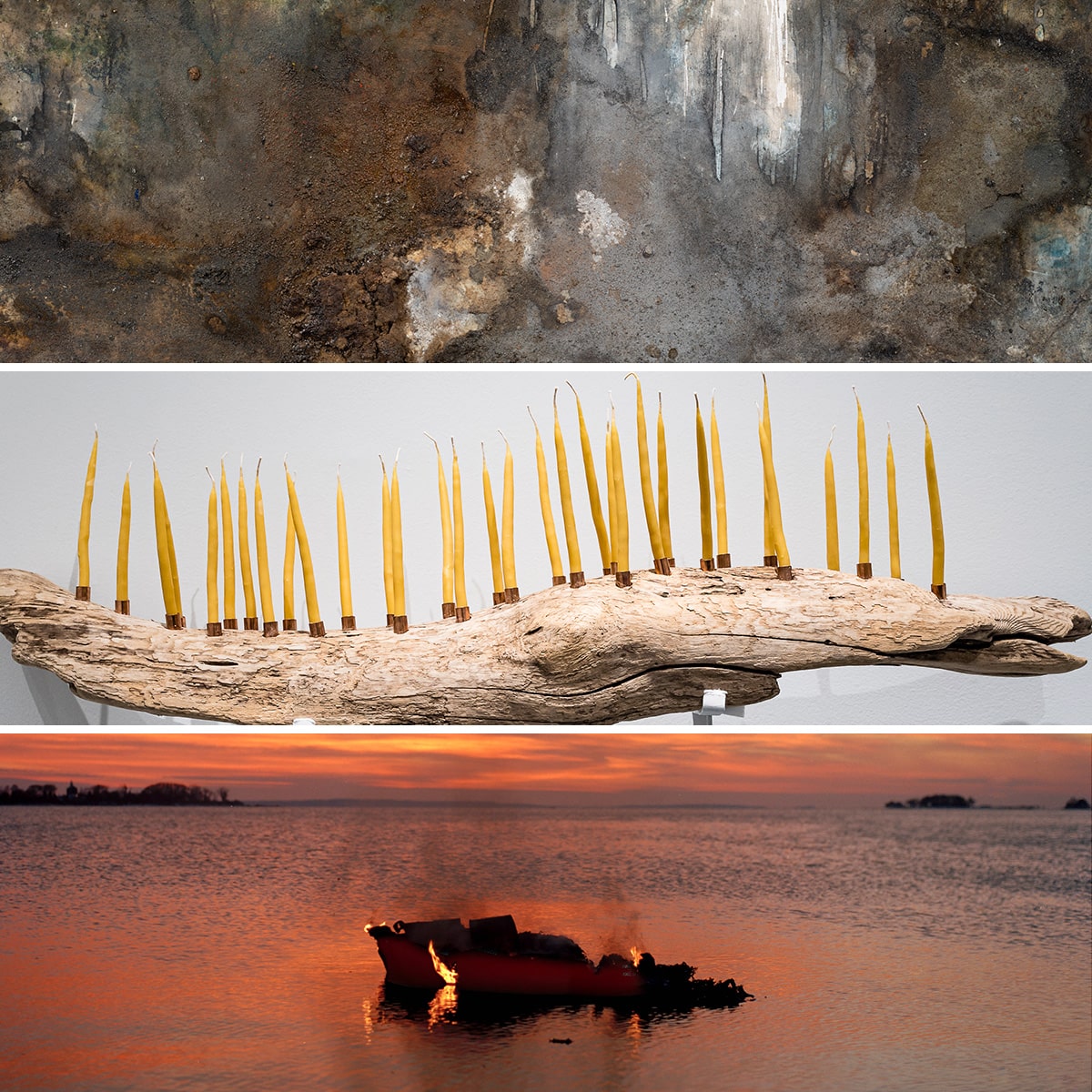To See This Place: Awakening to Our Common Home
Saint Louis University's MOCRA presents the work of three artists who heighten our awareness of the spaces we inhabit and help transform climate despair into climate hope.
Sept. 5 – Dec. 14, 2025
-
- 5 to 9 p.m. Sept. 5: Exhibition Preview
- 1 p.m. Sept. 6: Curatorial Talk
- 2 to 4 p.m. Sept. 6: Opening Reception
- 2 p.m. Oct. 5: A Conversation with Athena LaTocha
- 5 p.m. Oct. 27: Mary Mattingly: The Kristen Peterson Distinguished Lecture in Art and Art History
Ten years ago, Pope Francis published Laudato Si’: On Care for Our Common Home, a wake-up call addressing the global ecological crisis. Drawing on disciplines ranging from climate science to sociology, Francis proposed an “integral ecology” linking our treatment of the environment with our treatment of fellow human beings. Laudato Si’ also expresses the conviction that the arts and artists play a crucial role in combating climate change and healing relationships.
Curated by Al Miner and MOCRA Director David Brinker, To See This Place presents work by Athena LaTocha, Mary Mattingly, and Tyler Rai. Spanning the disciplines of painting, photography, sculpture, video, and performative art, and informed by intensive research, the work of these three artists resonates with the major themes of Laudato Si’. By awakening us to the particularities and interconnectedness of the spaces we inhabit, these artists help transform climate despair into climate hope and move us from awareness to action.
To See This Place is made possible with generous financial support from the Regional Arts Commission.
Explore the Exhibition
Gallery Guide / Guía a la exposición
Explore the Gallery Guide / Explore la guía a la exposición
Presentations
Watch an overview of MOCRA’s Fall 2025 exhibitions, To See This Place and Legacy:
Watch a conversation with artist Athena LaTocha:
Watch Mary Mattingly deliver The Kristen Peterson Distinguished Lecture in Art and Art History:
Laudato Si’
Pope Francis released "Laudato Si’: On Care of Our Common Home" in 2015 and a follow-up document, "Laudate Deum," in 2023.
If this seems like a lot of reading to tackle, there are many online guides to Laudato Si’ and ideas on how to respond to its calls to action.
Saint Louis University is a Laudato Si’ campus.
Learn about SLU’s commitments to promoting an integral ecology
To See This Place at Fairfield University
To See This Place was first presented at Fairfield University Museum of Art, Jan. 24 – Mar. 29, 2025. Take a video tour of the exhibition:
National Catholic Reporter published an article about the exhibition at Fairfield University.
Visit the Fairfield University Museum of Art website for additional content about To See This Place.
Explore the Exhibition at Fairfield University Museum of Art
About the Artists
Athena LaTocha
Athena LaTocha (b. 1969) is an artist whose works on paper explore the relationship between human-made and natural worlds. She incorporates materials such as ink, lead, soils and wood, looking at mark-marking and displacement of materials made by industrial equipment and natural events. Her works are informed by her upbringing in the wilderness of Alaska. LaTocha’s process is about being immersed in these environments, while responding to the storied and, at times, traumatic histories that are rooted in place.
Visit Athena LaTocha's Website
Mary Mattingly
Mary Mattingly (b. 1978) is an interdisciplinary artist whose work explores ecological relationships through sculptural ecosystems, performative installations, and research-based collaborations. Rooted in a deep inquiry into urban ecology and interdependence, her work addresses urgent issues around water, food systems and climate adaptation. At the core of Mattingly’s practice is a belief in art as a form of investigation and a tool for imagining adaptive futures. Her installations often function both symbolically and practically: creating space for gathering, co-learning, and reflecting on systems of resource extraction and ecological resilience.
Visit Mary Mattingly’s Website
Tyler Rai
Tyler Rai (b. 1991) is a transdisciplinary artist, ritualist, and producer who works across live performance, narrative essays, and experimental sound works. She draws connections between grief and mourning practices, biological and cultural inheritances, geologic time, and ecological change to reveal the poetic entanglements between spirituality, mythology, embodied experience and earth's ecological systems. She notes, “My body is an extension of the earth, and therefore the earth is always a research partner.”
About the Curators
Al Miner
Al Miner is an award-winning curator, educator and museum administrator based in Washington, D.C. Miner is deputy director for museum experience and digital eedia at the U.S. Holocaust Memorial Museum. He previously served as founding director and chief curator of Georgetown University’s art galleries where he was also associate professor of graduate museum studies. Miner has also held curatorial roles at the Museum of Fine Arts, Boston and the Smithsonian Institution’s Hirshhorn Museum and Sculpture Garden. He has authored three books and organized dozens of exhibitions, which have been reviewed widely in publications including The New York Times. Miner has received grants from the National Endowment for the Arts, The American Alliance of Museums and other organizations.
David Brinker
David Brinker is director of the Museum of Contemporary Religious Art (MOCRA) at Saint Louis University — the first museum to focus on the spiritual and religious dimensions in contemporary art. First volunteering at the museum as an undergraduate student, then joining the staff in 1995, Brinker has been deeply involved in every aspect of the museum’s operations and growth. He assumed the role of director in 2019. He has overseen important initiatives such as the MOCRA Voices podcast, and curated or co-curated numerous MOCRA exhibitions.
